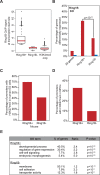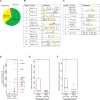Genomewide analysis of PRC1 and PRC2 occupancy identifies two classes of bivalent domains
- PMID: 18974828
- PMCID: PMC2567431
- DOI: 10.1371/journal.pgen.1000242
Genomewide analysis of PRC1 and PRC2 occupancy identifies two classes of bivalent domains
Abstract
In embryonic stem (ES) cells, bivalent chromatin domains with overlapping repressive (H3 lysine 27 tri-methylation) and activating (H3 lysine 4 tri-methylation) histone modifications mark the promoters of more than 2,000 genes. To gain insight into the structure and function of bivalent domains, we mapped key histone modifications and subunits of Polycomb-repressive complexes 1 and 2 (PRC1 and PRC2) genomewide in human and mouse ES cells by chromatin immunoprecipitation, followed by ultra high-throughput sequencing. We find that bivalent domains can be segregated into two classes -- the first occupied by both PRC2 and PRC1 (PRC1-positive) and the second specifically bound by PRC2 (PRC2-only). PRC1-positive bivalent domains appear functionally distinct as they more efficiently retain lysine 27 tri-methylation upon differentiation, show stringent conservation of chromatin state, and associate with an overwhelming number of developmental regulator gene promoters. We also used computational genomics to search for sequence determinants of Polycomb binding. This analysis revealed that the genomewide locations of PRC2 and PRC1 can be largely predicted from the locations, sizes, and underlying motif contents of CpG islands. We propose that large CpG islands depleted of activating motifs confer epigenetic memory by recruiting the full repertoire of Polycomb complexes in pluripotent cells.
Conflict of interest statement
The authors have declared that no competing interests exist.
Figures




References
-
- Schuettengruber B, Chourrout D, Vervoort M, Leblanc B, Cavalli G. Genome regulation by polycomb and trithorax proteins. Cell. 2007;128:735–745. - PubMed
-
- Sparmann A, van Lohuizen M. Polycomb silencers control cell fate, development and cancer. Nat Rev Cancer. 2006;6:846–856. - PubMed
-
- Ringrose L, Paro R. Polycomb/Trithorax response elements and epigenetic memory of cell identity. Development. 2007;134:223–232. - PubMed
-
- de Napoles M, Mermoud JE, Wakao R, Tang YA, Endoh M, et al. Polycomb group proteins Ring1A/B link ubiquitylation of histone H2A to heritable gene silencing and X inactivation. Dev Cell. 2004;7:663–676. - PubMed
Publication types
MeSH terms
Substances
Grants and funding
LinkOut - more resources
Full Text Sources
Other Literature Sources
Molecular Biology Databases

